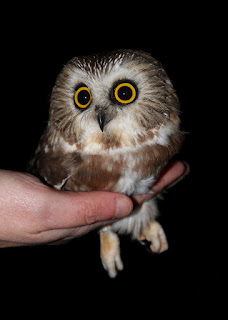Here you can see the location of HB's radio- somewhat obscured by her feathers- placed properly on her back. She has preened her antenna which is why it is kinked (Glenn photo).

Julie Shaw, CSU Chico grad student researching winter roosts sites of the saw-whet, called me and said "HB is low in a toyon, do you want to take her harness off?" HB is our remaining BCCER owl that still had a radio, for 91 days. Because the radios or so small (see earlier post "tracking the saw-whet"), they last only about 90 days-so we knew the battery would die soon. HB has been alternating in high (85') to low (3-6') perches and this day she was low. Although the radio harness or backpack is designed to bio-degrade, hers was still intact and I wanted to remove the backpack to set her free of any impediments caused by us. HB presented us with a perfect opportunity! Julie's trackers Glenn and Shannon took some of following photos-thanks!
Removing the harness
Step 1: find the bird. There she was about 6 feet high in a toyon shrub (Julie Shaw photo)
Step 2; Capture. There are many ways to capture a roosting saw-whet. I chose to use a capture technique where, with an extension pole, I place a coated loop around her head and wing. This immobilizes her temporarily while Julie then can hand catch her, as the second picture shows
(Shannon photos).
Preparing to capture
 | HB is safely captured
|
And happily, Julie has safely secured HB (Shannon photo)
Step 3: Remove the harness. Next we find the harness material and clip it with scissors, and remove the backpack and radio. HB, in the second pic in this cell, is now free of her harness (Shannon photos).
removing the harness  | harness-free  |
Step 4: check body condition. We want to check her body condition to see make sure the harness did not cause problems. Her keel (breastbone), felt fleshy on each side- indicating she was flying and eating well. We knew this though because Julie had found many pellets (regurgitated bones and fur/indigestible prey parts), and we alway saw urates below her roost, also indicating she was eating, thus hunting well. We checked her skin for potential abrasions from the material/radio- and fortunately there were none (Shannon photos).
We also weighed her and found that she was 97 grams, up 3 grams from her original mass of 94 grams! HB, a darling owl, who gave of lots of information about the wintering habits of saw-whet owls (Glenn photo).

Step 5: release. We released HB with high hopes that she would continue her success through the breeding season, likely somewhere in the Sierra Nevada Range, and thanking her for enlightening us to what habitats and prey (Julie collected almost 45 pellets that she will analyze for species composition) some saw-whet owls will take advantage of during the winter. These insights are invaluable for saw-whet owl conservation (Julie photo).
And as with any happy ending, we had a fantastic sunset as we exited the BCCER
(Dawn photo)!















